RESPLENDENT RECORD
Elephants, the Architects of the Wild
CREATING WILD COAST
TENTED LODGE

Arrack Attack!
Conserving the Peak Ridge Forest Corridor
VOL 01
Pg 19 Pg 35
Pg 13 Pg 4
A Travel and Sri Lankan Culture Magazine

1
Resplendent started in 2005 to create a collection of boutique luxury resorts that form a unique trail across the vibrant island of Sri Lanka.
We are a family of tea-makers and I suppose you could say accidental hoteliers, born from our commitment to ethical tea production and a genuine pride in sharing our country with interested visitors from abroad. My father, Merrill J. Fernando, founded Dilmah Tea back in 1988, at the tender age of 58!


As the first producer-owned tea brand – and with the country’s rich history – people were longing to visit our tea estates so my father Merrill, brother Dilhan and I began thinking of ways to showcase our pristine Ceylon tea country to visitors from abroad. Originally these were unofficial tea tours with visitors staying in our estate managers homes, touring the factories and the plantations. We were amazed at how much they loved their experiencesthe hotel side of the business grew from this.
We formed a company, Resplendent Ceylon (Sri Lanka means “Resplendent Isle”), to develop and manage these unique resorts. The goal is to offer the curious traveller a range of experiences linked to Sri Lanka’s history, culture and nature. The first resort was the award-winning Ceylon Tea Trails in the Central Highlands. This was followed by Cape Weligama, a luxe cliffside retreat near Galle and then Wild Coast Tented Lodge. Resorts in the Cultural Triangle; near Sigiriya and Trincomalee are next.

We are excited to publish the first Resplendent Record, featuring some of our community-based initiatives and other stories that are close to our hearts. I hope you enjoy reading it.

Watch the Fernando family short film
VOLUME 01 2
Malik J. Fernando
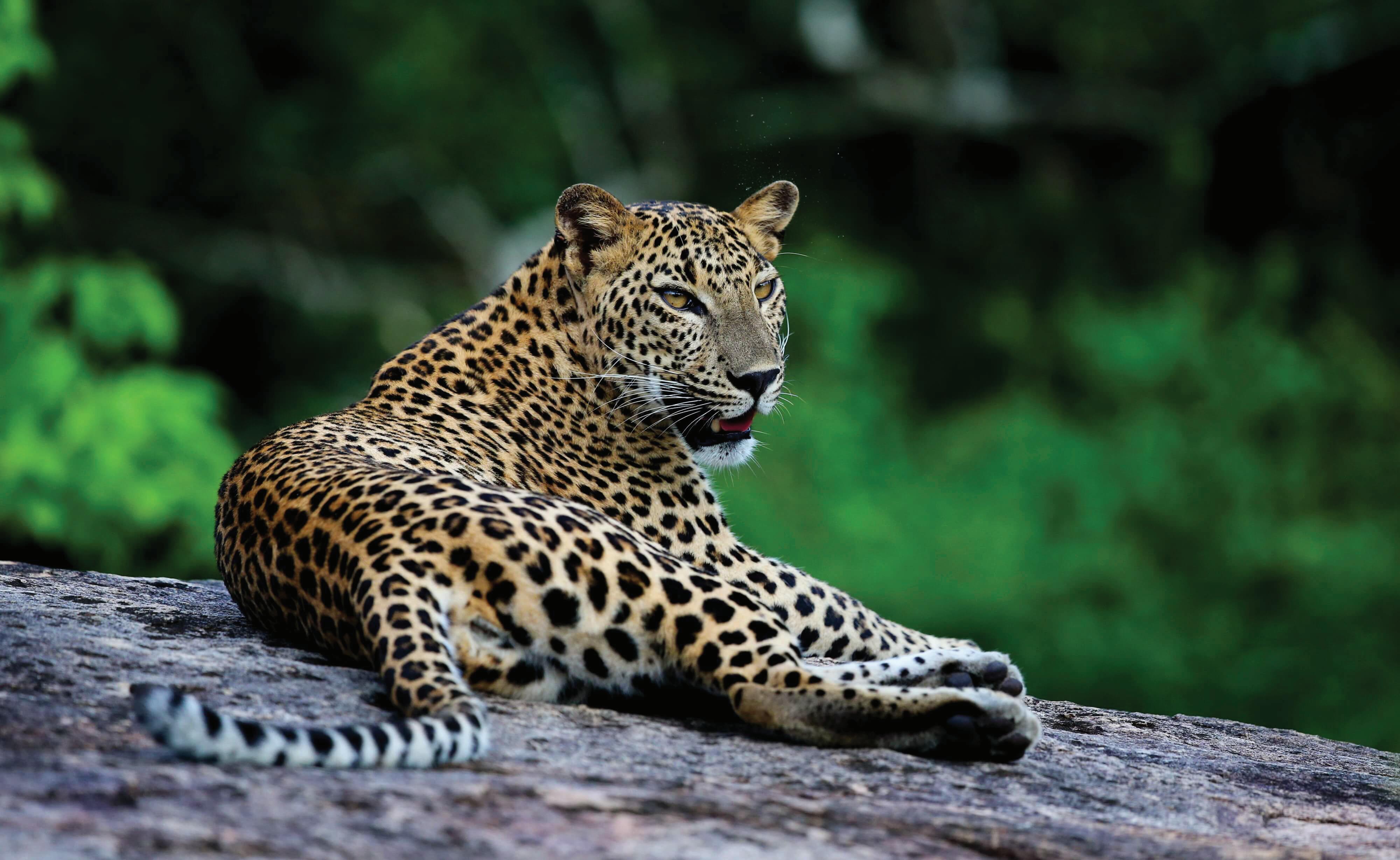
3
CONSERVING THE PEAK RIDGE FOREST CORRIDOR

VOLUME 01 4
Resplendent Ceylon, the Wilderness and Wildlife Conservation Trust (WWCT), Dilmah Conservation and several tea estates have embarked on a ground-breaking private sector collaboration to protect Leopards in the Sri Lankan tea highlands.

A Memorandum of Understanding was signed in February 2021 to help protect Leopards and other biodiversity on an 18km mountain ridge between Castlereagh and Moussakelle reservoirs, near Ceylon Tea Trails and adjacent to the 224 sq km Peak Wilderness Sanctuary.
The initiative not only includes a multi-stakeholder collaboration but is the birth of a financial model where conservation efforts can be funded through tourism.
In 2016, several leopards fell victim to snares in the vicinity of Ceylon Tea Trails. This drew attention to the fact that leopards were present outside the Peak Wilderness protected area, along the ridge directly behind Tea Trails. Resplendent Ceylon invited WWCT, a leopard-focused research and conservation organisation headed by Anjali Watson and Andrew Kittle, to set up a research station on Dilmah’s Dunkeld tea estate, near Tea Trails Dunkeld and Castlereagh bungalows.
WWCT began their work into leopard dynamics on the ridge. The findings were astounding as they discovered, with extensive camera trap footage, that there was a significant population of leopards along the ridge between the two reservoirs, outside the Sanctuary. The ridge, which we dubbed the Peak Ridge Forest Corridor, connects two sections of the Peak Wilderness Sanctuary.
More than half of Sri Lanka’s leopards exist outside protected areas (national parks), and this ratio is even higher in the central highlands where a significant proportion of the land use is for the growing of tea. This translates to leopard populations that coexist in human-dominated areas – a recipe for potential human-wildlife conflict with an endangered and keystone species.
This collaboration is private sector-led and supported by scientific research, a pioneering step for a more sustainable Sri Lanka. It is the birth of a new conservation model that could be scaled to protect our natural assets and support the work of government agencies, vital at this juncture of habitat loss vs. economic aspirations of a developing economy.
Resplendent Ceylon is also embarking on creating economic means for conservation through tourism. For the reforestation programme, the Tea Trails team have identified land within Dilmah’s Dunkeld estate where thousands of trees will be planted. This will increase forest cover for leopards and prey, while also re-introducing native tree species to the highlands that were removed to plant pine for timber decades ago.
This is the beginning of the Peak Ridge conservation project, but it is also the start of light being cast on the leopards of the highlands. Leopards are mysterious creatures, especially these, as they have often been lost in the narrative of the highlands of Sri Lanka. As this story unfolds, we look forward to taking you with us on this journey with the leopards of the Peak Ridge Corridor.
5

VOLUME 01 6
THE SEASON OF RAMBUTAN
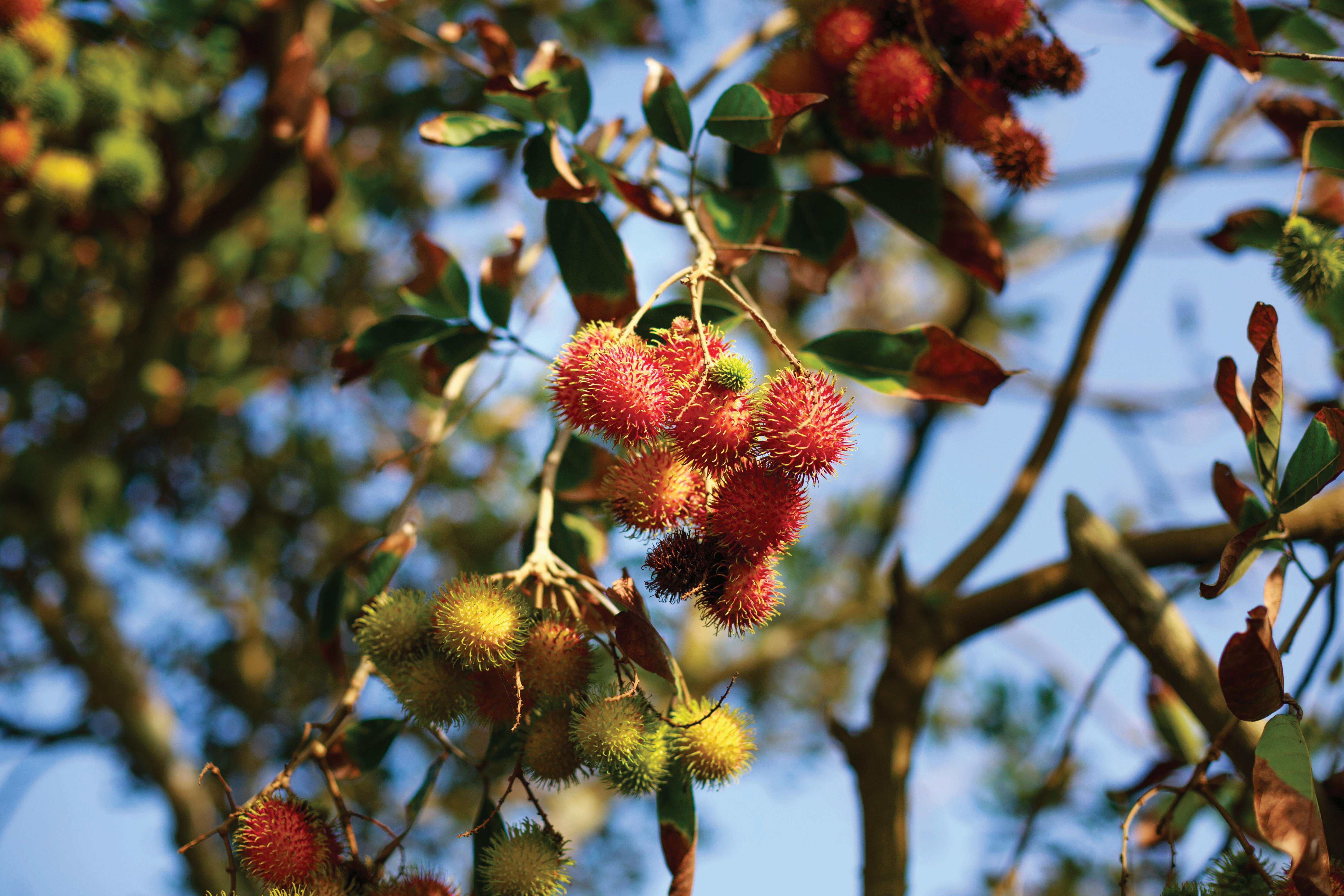
7
While they all have white flesh and grow on trees, the rambutan, lychee and longan are three different fruits, although cousins in some ways.
Rambutan season on our island begins in May and stretches into the month of August. It is typically grown in the wet zone, in main districts including Gampaha, Ratnapura, Kandy and Kegalle. This quintessential tropical fruit grows to about the size of a golf ball in large clusters, and its signature prickly hairs that sprout from a coarse outer skin is what makes the fruit easily identifiable. The fruit derived its name from the Malay word ‘hair’ which translates to ‘rambut’.
Here’s five things to know about Rambutan;

The fruit is rich in several minerals and vitamins including Vitamin C that helps absorb dietary iron into the body easily, and copper - which plays a role in cellular growth and maintenance.
The rambutan peel and seed are thought to be rich sources of nutrients, antioxidants and other beneficial compounds. Though some people eat them, neither are considered edible.
It has a rich, creamy and sweet taste which is very refreshing.
The fruit can be eaten fresh or in jams, jellies, desserts and drinks..
The redder the fruit, the riper it will be.
01
02
03
04
05
VOLUME 01 8
OUR FOOD PHILOSOPHY

Experiencing local cuisine is an integral part of visiting our resorts. We like to think of each plate, every dish, the ingredients used as an expression, an indication of its connection to nature, our island home and the creativity of our chefs. Our offering is linked to both grounded intention and a deep sense of purpose; to nurture and nourish not just the body but also mind and spirit. Our kitchen embraces the diversity of seasonal produce, looking to small local producers and farmers, fishermen and communities that strengthen connections and harvests that are wholesome, nutritious and clean.
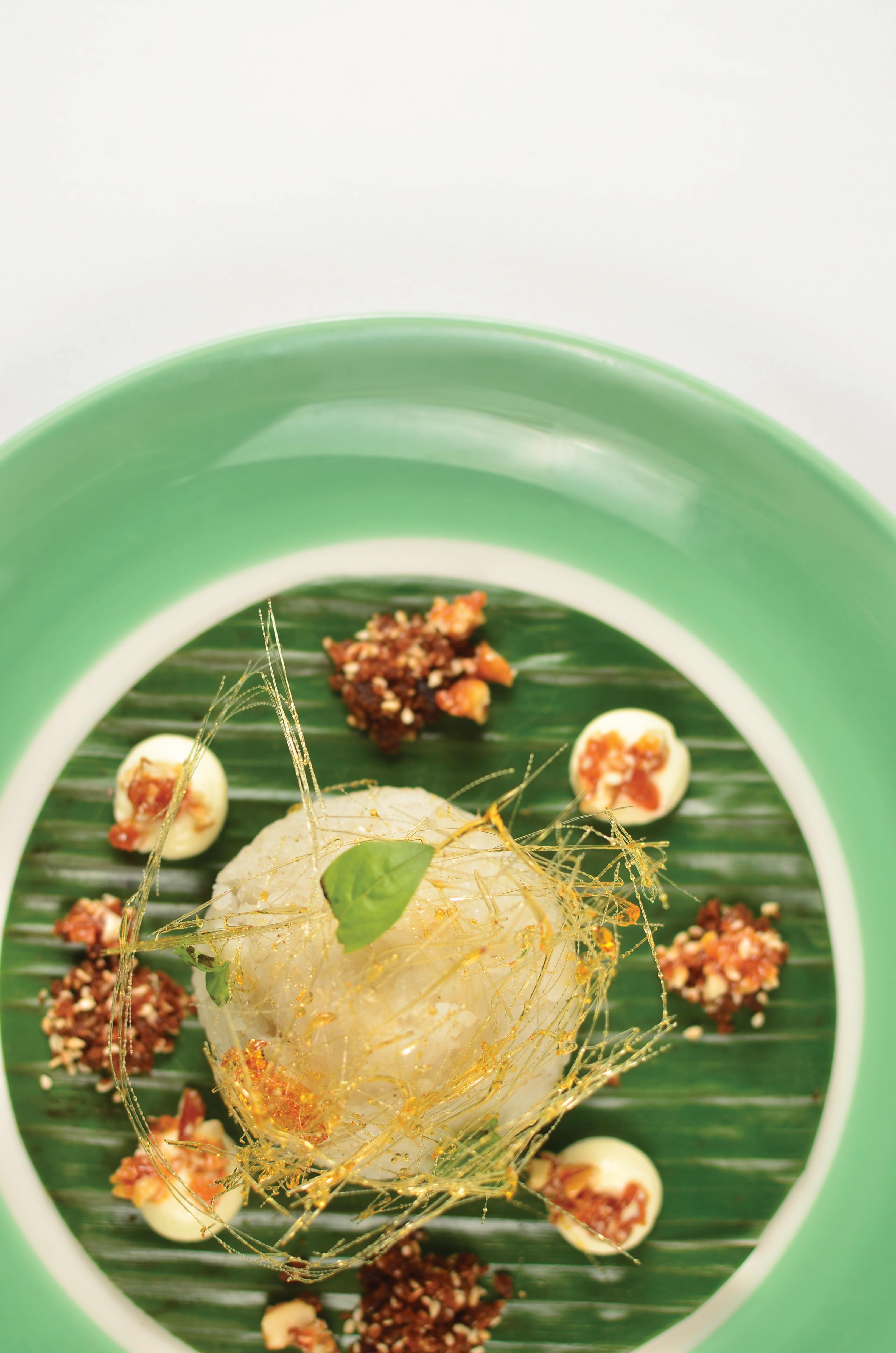
The menus are constantly changing therefore and are inspired by the surroundings and the freshness of local produce. No two meals are alike; each a visual and gastronomical representation and celebration of seasonal fresh flavours. We also find that flavours have a way of connecting memories, moments and emotions. Tastes, smells and textures can be highly evocative, moody even and bring back memories of not just eating food itself, but also when, where and with whom. When you dine with us, you embark on an epicurean journey of creating a new set of memories and moments that you’ll come to savour and cherish in time.
Our chefs are dynamic, gifted and deeply passionate about what they do. Each bears a unique sense of style, inspiration & food philosophy. Whether you are looking to indulge or seek a comforting sublime approach to food, this is your invitation to experience it from farm to table.

Click here to view our Story of Flavour short film 9
- caramelised grated coconut stuffed milk rice, sesame and jaggery crumble, kithul (palm treacle) reduction

VOLUME 01 10
Imbul Kiribath
HYPERLOCA L COCKTAILS

Discover the Ten Tuskers Bar at Wild Coast Tented Lodge, which features handcrafted cocktails with hyperlocal ingredients. Sit alongside the pool, overlooking the Indian Ocean and allow yourself to journey across a tasting of liquid aperitifs. The space, crowned by a large bamboo chandelier, sets the tone for an evening of relaxed pleasure. Dusk arrives with its glorious pastel, golden hues; the mixologists are at the ready.
A cocktail tasting aligns drinks in sequence; each advancing in sense, taste, richness and quality. It eases the drinker through a range of flavours and temperatures. There’s a sense of purpose; a beginning, a middle and an end. Inspired by the natural surroundings, each cocktail is an amalgamation of hyperlocal ingredients, creative ingenuity and sheer passion for artistry. From the tangy sourness of tamarind to the high temperature emanating from scotch bonnets (locally known as kochchi), sweet king coconut water to fruity calamansi (locally known as narang), spicy green chillies and Indian gooseberries combined.
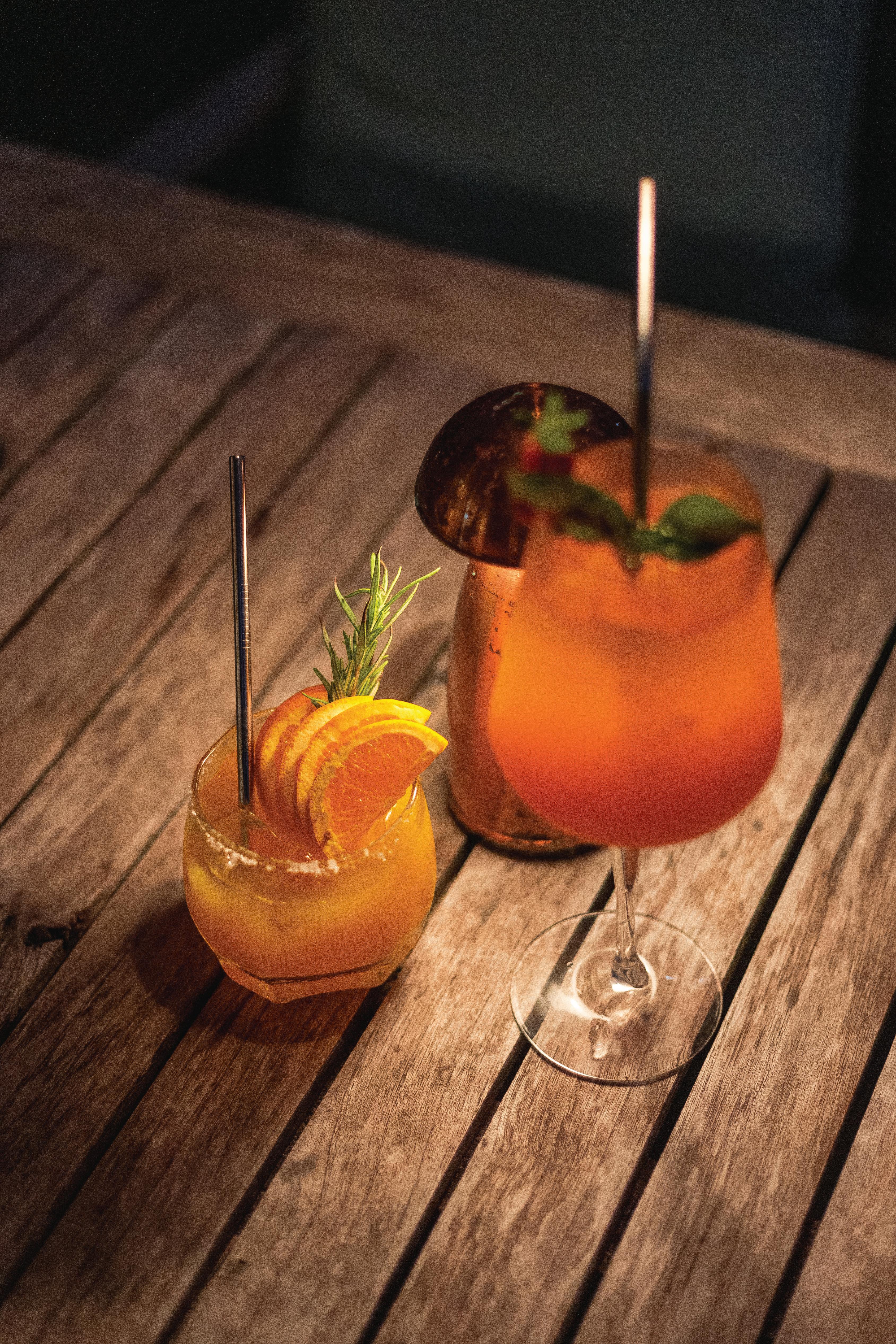
11


VOLUME 01 12
ARRACK ATTACK!
If you’re new to discovering arrack, you’ve come to the right island! Sri Lanka is the largest producer of coconut arrack - a distilled alcoholic beverage made from the fermented sap of the coconut flower. Apart from water, the entire manufacturing process revolves around the fermentation and distillation of the sap, collected every morning at dawn by men, often referred to as ‘toddy tappers’ who move across the tops of the coconut trees using connecting ropes like tightrope walkers. A single coconut tree typically yields up to two litres of sap a day. Back in the early 1900’s arrack was never considered to be finely made nor particularly palatable. Over time that has changed. It is now a refined, special spirit.
Coconut arrack is traditionally consumed by itself or with ginger beer - a popular natural ginger-infused soda on our island. It is also mixed in cocktails as a substitute base for the required portions of either rum or whisky, contributing to a unique flavour and best paired with citrusy fruits and even the most diverse of ingredients including chocolate, coffee, chilli and ginger. Inspired by the natural surroundings, each arrack cocktail crafted by our mixologists is an amalgamation of hyperlocal ingredients and creative ingenuity.
Click here to find out how to make your own arrack cocktails, by our friends at Rockland


13

VOLUME 01 14
G ROWING OUR OW N P RODUCE

Whilst the disruptions to the global supply chain and local import regulations challenged the food chain for the hotel and restaurant industry, it has also encouraged us to explore indigenous ingredients and curate menus focused on hyperlocal produce. We’ve taken the time to rediscover lost Sri Lankan heirloom crops and grow our own. We have emerged more in tune with a bountiful basket of local produce that form the heart of our culinary offering at our resorts.
The farm-to-table catchphrase may seem a tad cliched, but we’ve upped the freshness ante by encouraging the idea of eating locally and seasonally. The passion for good food begins in our very own garden patches. Maintained by our chefs, we have an increasing quantity of herbs, chillies and organic vegetables including carrots, radish, kangkung (water spinach) and spinach, lettuce and aubergine. Innovative composting methods on site which create organic liquid fertiliser are used to keep these gardens healthy and flourishing.


15
REVITALISING OU R OCEANS
The oceans and our livelihoods are inextricably linked, especially in our beautiful island home of Sri Lanka. While the impacts of climate change and unsustainable seafood harvesting threaten the livelihoods of local fishermen, Dilmah Conservation, our conservation arm, is seeking to change this.

Seaweed is an often overlooked product of our oceans, especially in Sri Lanka, where its use has been minimal. Dilmah Conservation, in partnership with the National Aquaculture Development Authority, is training ten local fishermen on the country’s northwest coast in Mannar’s Arripu and Pesalai areas in a pilot project to increase seaweed farming.

While serving as a local ingredient in our menus at our resorts, the sale of this kappaphycus alvarezii or elkhorn sea moss harvest, both locally and globally, will directly uplift the lives of these fishermen by providing them with a sustainable alternate livelihood.
On World Oceans Day, we highlighted the efforts of this very first harvest in our menus, offering exquisite dishes featuring seaweed by our incredible chefs at Ceylon Tea Trails, Cape Weligama and Wild Coast Tented Lodge. We will continue to encourage a culture of change and respect for our oceans among our guests and ambassadors.

VOLUME 01 16
FIVE WAYS TO APPRECIATE CEYLON TEA

17
Brew with care and intent. Drinking tea is a very personal and calming experience and it should be brewed the same. Unhurried.

Scan the QR Code to discover how to brew the perfect cup of tea.

There are many health benefits to drinking tea as is, however, adding fresh ginger and honey amplifies those benefits and provides an earthy, comforting flavour.
Take slow sips. This allows you to notice flavours, sensations, any textures around the tongue and appreciate the tea a whole lot better.
Tea time is a special time in Sri Lanka and best paired with a comforting view. At Ceylon Tea Trails, you are spoilt for choice when it comes to scenic vistas.
Tea paired with cuisine in yet another way to appreciate it. The tea-infused dinner at Ceylon Tea Trails is a signature culinary experience.

01
02
03
04
05
VOLUME 01 18
CREATING WILD COAST TENTED LODGE
Sri Lanka, known for its biodiversity and array of wildlife, has seen nothing quite like Wild Coast.

19

VOLUME 01 20

21

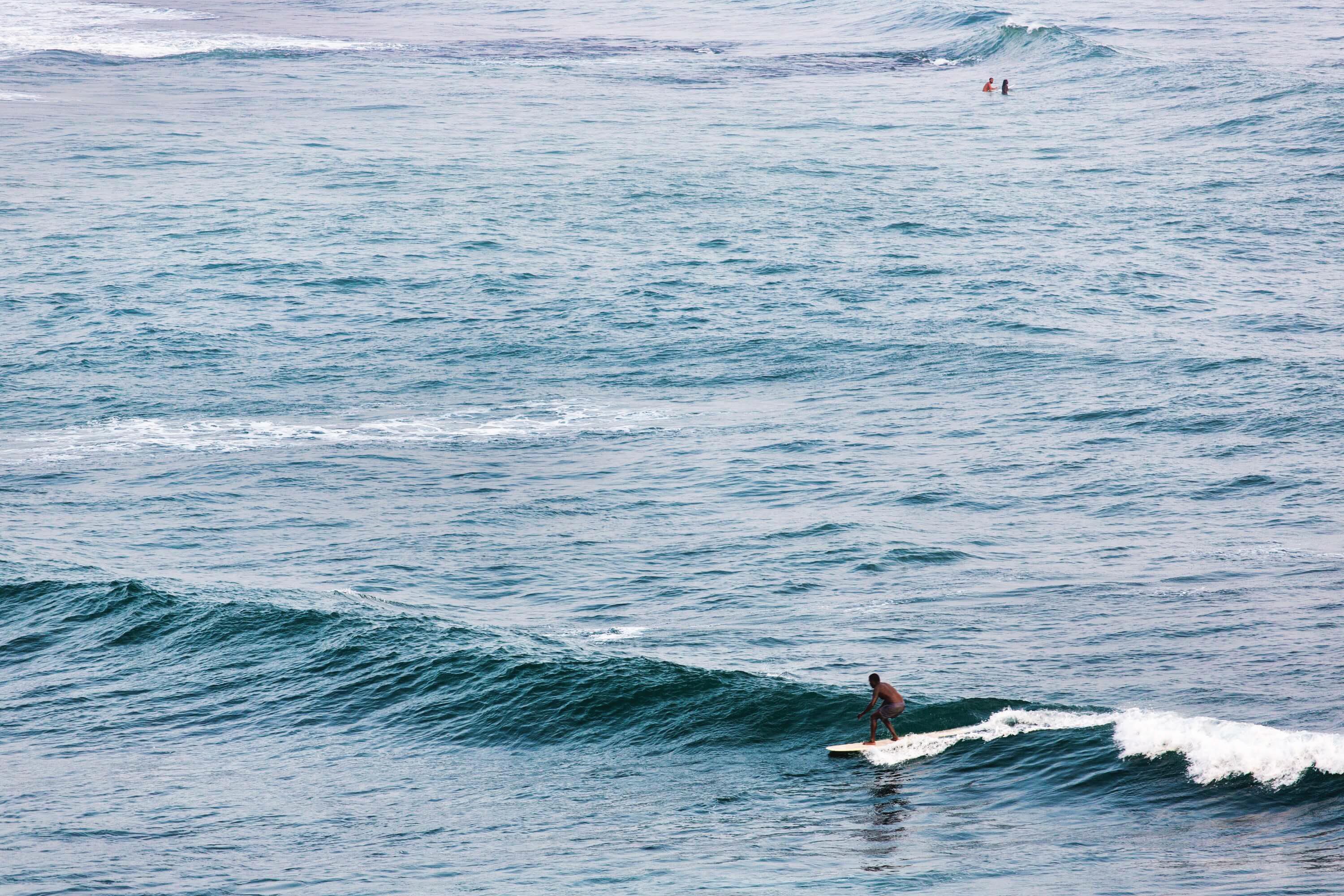
VOLUME 01 22


23
Wild Coast Tented Lodge, situated next to Yala National Park, has set a new standard for luxury safari lodges. Sri Lanka, known for its biodiversity and array of wildlife, has seen nothing quite like Wild Coast.

Nomadic Resorts were the designers; known for developing unique designs through sustainable architecture, contemporary bamboo construction, regenerative landscape form and low-carbon engineering. They were the ideal collaborator for Wild Coast as we sought not only to create a luxury tented resort unique in design, but also sustainable.

Whilst the architect designs the body, the interior designer is assigned to bring the body to life. Renowned interior designer Bo Reudler sought to capture a feeling of exploration and wonder. His aim was to celebrate local craftsmanship and high-quality materials that age gracefully.
The lodge is characterised by rocky outcrops scattered across the landscape. These forms are echoed in the architecture of the resort, with boulder-like pavilions formed organically together. The ambition to minimise environmental impact and the isolated nature of the site demanded a locally-focused, sustainable approach with natural materials sourced locally as far as possible, and celebrating vernacular traditions such as mud-brick and bamboo construction.
As for interior design, as the architecture of the main pavilions resembled the rocky outcrops, Reudler’s team was inspired to look at everything you can encounter inside of rocks: caves, veins of precious metals, and sparkly crystals. Sri Lanka’s nature, culture and crafts also played a role in influencing the design.
As for the unique Cocoon tents, the look and feel of an anchored airship was the main inspiration. The lodge’s waterfront bar, restaurant and library are enclosed within two dome-shaped structures clad in reclaimed teak shingles designed to imitate the local landscape. “At the site, you can find massive boulders along the coastline,” explains Olav Bruin, creative director at Nomadic Resorts.

VOLUME 01 24
Scan here to watch the Wild Coast Tented Lodge Film
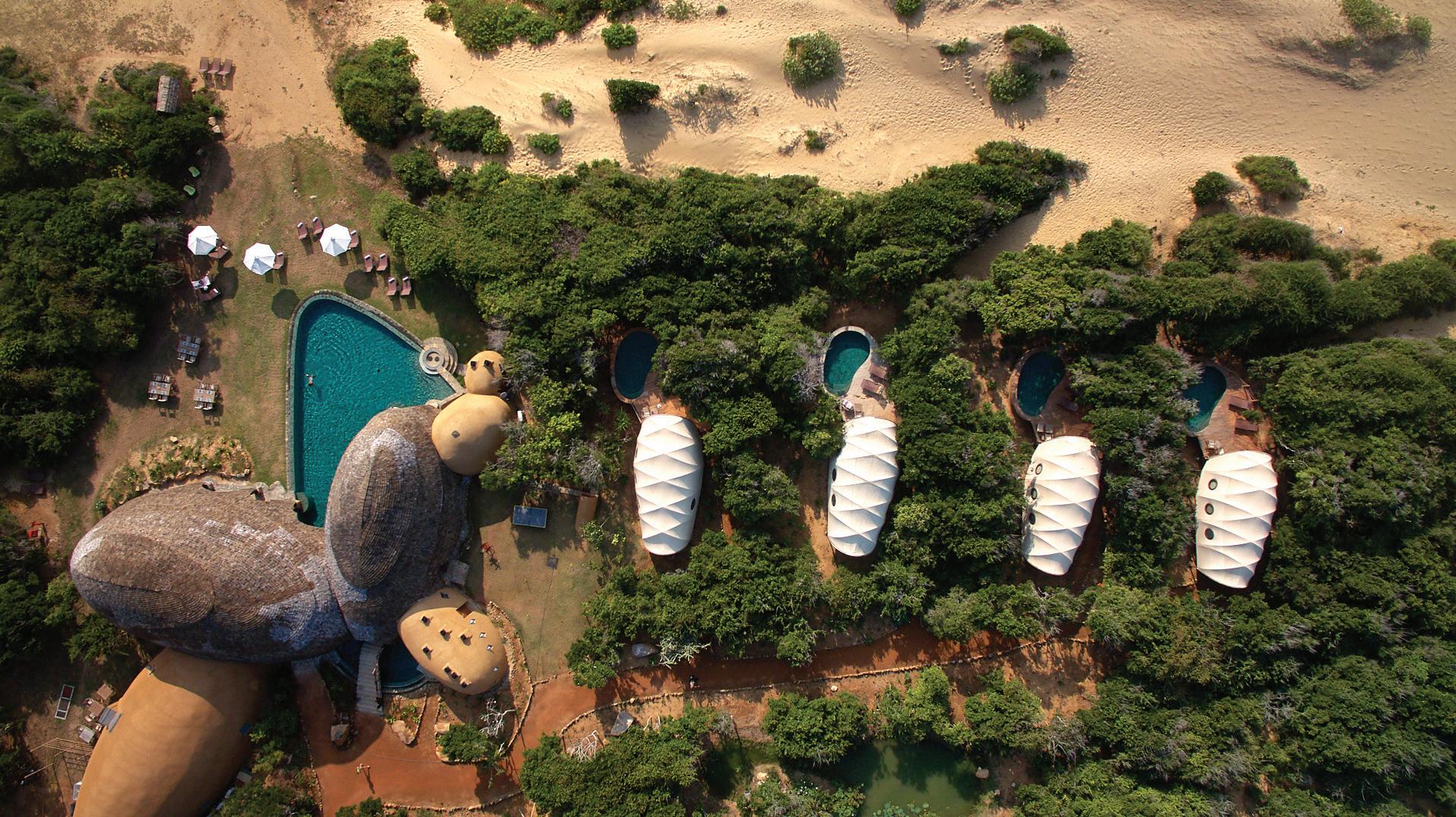
25

VOLUME 01 26
“So, when we started sketching and brainstorming the same evening after our visit, we felt that the best approach would be to design buildings that would become part of the natural surroundings, and we shaped them like a cluster of intersecting boulders. At a more detailed level, it was important to us that the buildings would weather gracefully. We chose to therefore use reclaimed teak shingles with a rough surface. These will turn grey over time with different tones, which will make the buildings look even more like the surrounding rock surfaces.”
Within the bamboo structures, seating was made from a combination of elephant dung and clay. “Excavated stone and locally quarried quartz are used widely throughout, and residue clay from the gravel-sifting process was mixed with elephant dung – an abundant resource – to create the restaurant and welcome-area mud-brick seating,” said Bruin.
Alongside the main buildings, the studio placed 36 lightweight cocoon-like structures within the forest that act as guest rooms. These buildings were prefabricated off-site to minimise the impact during construction and raised on stilts to reduce the impact on the landscape. They are designed to be disassembled and leave only a minimal impact on the site.
The project faced many setbacks. The team responsible for the construction of the bamboo structures had to pull out at short notice. With deadlines looming, this was an unexpected challenge with no easy solutions, as not just anyone could be recruited to construct a bamboo structure of this design and scale.
A decision was made to recruit and train the local fishermen of nearby Kirinda. 80 fishermen with no prior experience in construction, let alone bamboo, were given a crash course and began their work. They exceeded all expectations; were fast learning and delivered an outcome that resembled a team of craftsmen who have worked with bamboo for years.
The Kirinda fishermen made the project more meaningful, as engagement with the local community is something Resplendent Ceylon values highly. Wild Coast Tented Lodge was opened on 27 October 2017 by Dilmah Tea Founder Merrill J Fernando.

27

VOLUME 01 28

29


VOLUME 01 30
RIDE TH E WAVES
Petter

founder of Ceylon
Weligama is located at the heart of the southern coast surf circuit of Sri Lanka. Surfers from across the world come here to catch the waves along with enhancing some of their skills through the many surf schools dotted along the coast.

There aren’t typical ‘seasons’ in Sri Lanka like the west, but our weather is dominated by the two monsoons experienced. Surfers typically categorise the seasons into two - summer and winter seasons - and two shoulder seasons in between. There is also the peak season when the breaks get stronger and the waters get busy.
The famous little island right at the fringe of Weligama Bay provides a really fun longboard wave, and occasionally a short board wave. This is ideal during the summer season, and every now and then during the shoulder season. It has a left and a right, each breaking along either side of the island. The bay is a favourite amongst surfers all across the world regardless of the time of the year, and we invite you to experience it yourself while staying at Cape Weligama.
Tolleman,
Sliders Surf School — Cape Weligama’s Surf Experiences partner, loves the bay of Weligama for its year-round surfing. He breaks down what the subtle changes in weather mean for a surf experience
Scan the QR code to view the Story of Surf short film 31

VOLUME 01 32
JOURNEY TOWARDS
ZERO WASTE
Our ambition towards zero waste across our resorts extends to our communities. The mounting production of plastics, owing to its cost-effective and convenient nature, together with irresponsible waste management practices, continues to exacerbate the environmental, social and economic impacts of marine pollution.
We believe collaboration and partnerships are the way forward to achieving our goals. Cape Weligama partnered with Eco Spindles to establish plastic waste collection points along the Weligama coast in an effort to prevent plastic waste from ending in our oceans. These units are made entirely of repurposed materials including discarded sunbeds from Cape Weligama, further easing impact on landfills.

The plastic waste collected is processed by Eco Spindles via innovative recycling technology to make clothing for export.
Weeva is a 360° sustainability management platform built for the hospitality sector. As a business that understands that our future depends on caring for our planet and its people, Resplendent Ceylon was given the opportunity to trial out Weeva in its beta stage. Now fully functional, all our resorts report across multiple parameters on Weeva including climate action, zero waste, zero pollution, sustainable and ethical procurement, employee learning and development and many more. The Weeva platform provides a framework using 18 parameters across the 4C’s – Conservation, Commerce, Community and Culture that guide businesses like Resplendent Ceylon to manage operations more sustainably. With target setting through Weeva, small, actionable steps through measurement enhances impact across our resorts in our ambition to attain our goals of Resplendent Ceylon’s Sustainability Journey 2030.
33

VOLUME 01 34
ELEPHANTS , THE ARCHITECTS OF THE WILD

35
Sri Lankan elephants (Elephas maximus maximus) are the largest of the Asian elephant sub-species although smaller than their African counterparts. They are true ‘ecosystem engineers’ or keystone species; species that have a significant impact on their ecosystems in comparison to their populations. This means the survival of that biosphere and its species – both flora and fauna – depend on keystone species to maintain the equilibrium on which the habitat functions.
Elephants are largely social animals that live within matriarchal societies, and the largest land mammal in Asia that traverse long distances foraging for food and water. While doing so, they essentially alter the distinct layers found within forest ecosystems. As the largest herbivores on land, elephants maintain a diet of grass, leaves and sometimes even bark which gives them some much needed roughage.

Following excretion of these digested materials, elephant dung is a holding cell of seeds which are dispersed as the animal forages. This all- important mechanism of seed dispersal contributes to new life in forests as not only sources of shelter from forest canopies but also food sources for other species as well. When elephants feed, they create gaps in vegetation. These gaps allow sunlight to filter through to the undergrowth of forest ecosystems while reducing competition, and allowing smaller plants to grow toward the forest canopy. These gaps, together with smaller trees and grasses that are trampled as elephants move around, create pathways for smaller animals.
Additionally, during the dry seasons, when water is a limited resource, elephants led by their matriarch will go in search of water. When water isn’t freely found, these intelligent creatures dig with their feet and their trunks until they hit water. The result of this search are wallows which provide respite to other animals during the dry season – many of which may not survive if not for these ‘watering holes’.
This majestic species appears in our own backyard at Wild Coast Tented Lodge in Yala where we truly live by our ethos of enhancing our biophilic connections. Our respect for these animals and their home means that these creatures are frequent visitors, along with a plethora of other species such as leopards, wild boars and sloth bears. Basking and drinking from Wild Coast's man-made watering holes that are fed by treated wastewater, and feeding on our numerous native florae, we aim to embody co-existence with nature by creating an environment where these animals feel safe.
15% of pre-tax profits from Resplendent Ceylon are directed to Dilmah Conservation and the MJF Foundation, supporting some of the most impactful actions in the country, including the Elephant Transit Home (ETH) where orphaned elephants are cared for before being released back into the wild.

VOLUME 01 36
Scan the QR Code to view the Elephant Transit Home film
SRI LANKA'S TEA TRAIN



37
Scan to watch Instagram drone video following the Tea Train across the Central Highlands. A must watch!
Described by rail enthusiasts as one of the world’s greatest train experiences, the hill country line is a winding, ascending railroad; slow and lovely. The soft rhythms of the train will lull you through the verdant hills, tiny rural stations, forest and precipitous views. Feel your senses stirring as you climb up through the highlands, surrounded by lush tea plantations and stunning scenery in every direction.
It’s 4.45am and I could do with some more sleep. However, I am up and about, showered and ready to leave home - destination Colombo Fort. I suppose I need not have woken up that early as it only took me a mere couple of minutes to get there, get my ticket and make my way onto the Podi Menike.
The train itself is a tad old-fashioned, however I’m booked into the First Class carriage and this is somewhat more modernised - television screens at intervals with a movie playing throughout the ride, charging ports and the comfort of air-conditioning. Trains came into existence sometime in the 1800’s when my little island was under British colonial rule. At the time, the carriages were used to transport tea from the plantations to the city of Colombotoday, thankfully, many locals as well as foreign travellers find it a convenient mode of transportation to many parts of the country.
The Podi Menike is scheduled to leave Colombo Fort at 5.55am and although I’m told there can be delays, we left the station on the dot on this particular occasion. Typically, the estimated arrival time to Hatton is 11.25am. This can tend to vary however as there is the possibility of longer stops and some delays throughout the journey. There are certain bumpy areas along the way and the ride could be a little longer than expected but, I do think the views make up for it.
If, like me, you wish to get some great photos and videos of the scenic changing views, you’ll need to get seating on the best side of the train. Seats on the right side of the train are great and you could also walk over to the entry and exit doors for some extra instagram-worthy snaps along the way. I would also recommend having some snack or breakfast bars and water with you even though shorteats and water are sold during the journey. I say this because morning tummies can tend to be temperamental and it’s always better to have your own reusable water bottle instead of purchasing a plastic non-reusable one instead. Consider your gut health and the environment.

Did I mention the views? Oh, the glorious views! I don’t think I can unsee them when I think about the train ride now. There’s something quite ethereal - a scenic sort of elegance - to the mountainscape, the high rises and low slopes of the valleys, the forestry, the paddy, the tea. You could almost reach out and feel the freshness of the air, the crispy cool breeze. On this particular day, there was sunshine in pockets of time, and mist and rain during the others. It felt like setting foot in a different time and place both at the same time. A newness for the senses to feast upon.
The many photos and videos do not do justice to the reality of the experience however. Escaping the city and entering the highlands is quite something else - not something that can be translated through imagery and content but rather through emotions and sensitivities within. That’s how I felt. It didn’t matter that I felt sleepy. It didn’t matter that the journey at times felt longer. It wouldn't matter to you either. Trust me on this one.
For train schedules, booking tickets online and other relevant information, kindly email us at reservations@resplendentceylon.com
Scan to watch parts of the BBC “The World Most Scenic Train Journeys”Bill Nighy narrates a train journey across Sri Lanka along one of the world's best-preserved Victorian railways. Watch from 18:41 mins where our Tea Trails Bernard Holsinger is interviewed about Ceylon Tea!



VOLUME 01 38
THE HISTORY OF CEYLON TEA

The story of tea in Sri Lanka began over two hundred years ago. British rule was very much under way and in the year 1824, the first tea plant was brought to Ceylon. It came from China and was planted in the Royal Botanical Gardens in Peradeniya for non-commercial purposes.

39


VOLUME 01 40
FORTUITOU S TIMING
James Taylor is widely regarded as the ‘father’ of Ceylon Tea. He hailed from Scotland and arrived on the island in 1852. He was sent to the Loolecondera Estate, a coffee plantation in the Kandy District, and was made its manager within five years as Ceylon went on to become the world’s largest coffee producer by 1860. Despite the success of coffee, the owners of Loolecondera suggested to Taylor that he experiment with tea. It was fortuitous timing as the coffee rust disease first made an appearance two years later, and within the following two decades, coffee was all but wiped out on the island.
In 1866, on the orders of G.D.B. Harrison, proprietor of Loolecondera Taylor collected tea seeds from the Peradeniya Botanical Gardens and planted them along the roadsides of Loolecondera. Success followed in a year, the first tea estate was born - Field No. 7 - expanding to 19 acres on the Loolecondera Estate, marking the birth of the industry.
Taylor started operating a fully-fledged tea factory at the Loolecondera Estate. Taylor's tea house or factory was of wattle and daub and had hessian lofts in which to wither the tea leaf. He was said to have invented a tea leaf roller, which was powered by a 20ft. water wheel.
The first sale of Loolecondera tea was made in Kandy in 1872. It consisted of two small packs of 23 pounds of tea. The Maskeliya Planter’s Association was established the same year in July as the tea experiment grew into a fruitful commercial enterprise.
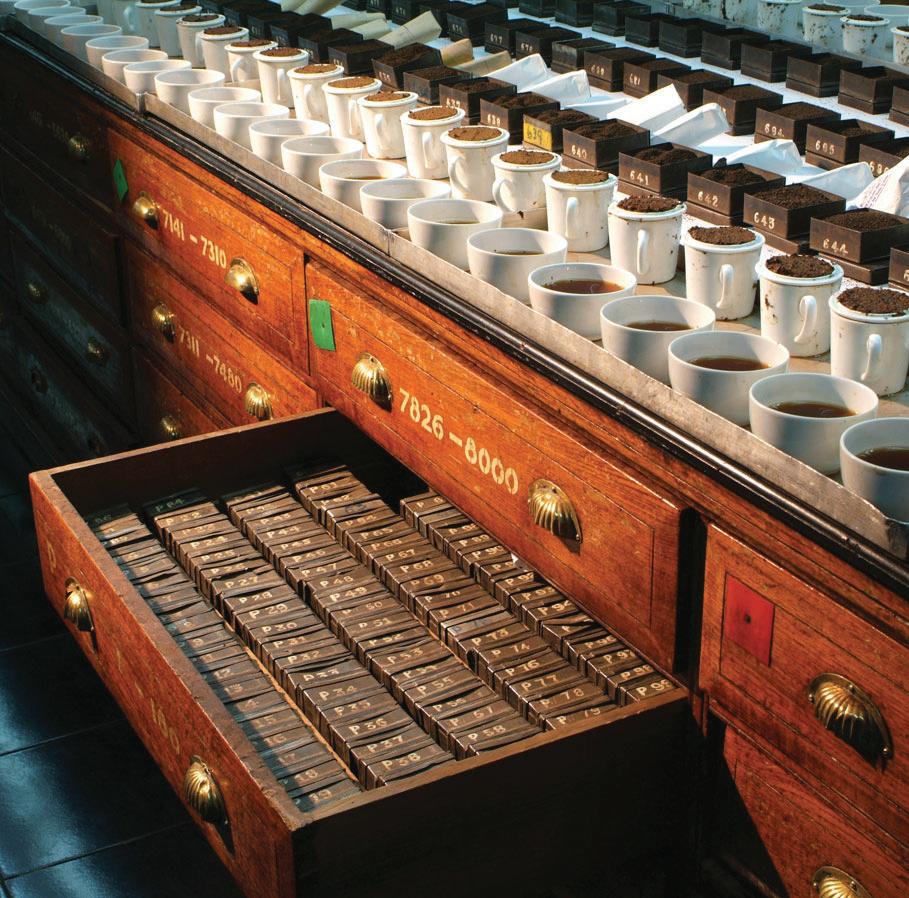
Watch The Story of Tea short film about a day in the life of a tea planter

41

VOLUME 01 42
EXPORT AND POPULARITY

43
This consignment of 23 pounds was the first shipment of Ceylon tea which arrived in London for auction in 1873. The value was set at Rs. 58; a hefty sum at the time.
Botanist Henry Trimen succeeded the legendary George Thwaites as Director of the Royal Botanical Gardens, Peradeniya in 1880. Trimen presided over the critical transformation period from coffee to tea and his contribution was second to none. The first successful tea-rolling machine was also invented in the same year by the Walker brothers and manufactured by their firm, John Walker & Co.
As Ceylon tea gained popularity throughout the world, the first public auction in Ceylon was held on 30 July 1883 at the premises of Somerville and Co. along Queen Street now renamed Janadhipathi Mawatha. The Auction was only modestly successful with one lot of Kabaragala un-assorted tea selling for 45 cents a pound, whereas the other four lots remained unsold due to a lack of bids or bids not meeting the Broker’s expectations. The Colombo Tea Auction is now considered the oldest and largest tea auction centre in the world. Despite debacles, Somerville & Co. and the other brokers persisted and were able to conduct auctions on a regular basis, promoting the common interest of both buyers and sellers of tea within the island and overseas.
John Walker helped build the first central tea factory in the Fairyland Estate (Mount Pedro) in 1884. The factory belonged to J. A. Rossiter.
In 1891 Taylor was presented with a tea and coffee service by the Planters Association, the inscription read “to James Taylor, Loolecondera, in grateful appreciation of his successful efforts which laid the foundation of the Tea and Cinchona Industries in Ceylon.” Sadly Taylor passed away the following year.
In 1894, the Ceylon Tea Traders Association was formed. All tea produced on the island is sold through this association and the Ceylon Chamber of Commerce.

In 1915, Thomas Amarasuriya became the first Ceylonese Chairman of the Planters Association, which was incorporated by an Act of Parliament in 1916. The Tea Research Institute began its operations in the year 1925 as an arm of the Planter’s Association in Nuwara Eliya, conducting research into maximising yields and improving methods of tea production.
Scan this code to explore the History of Ceylon Tea further

VOLUME 01 44
THE ESSENTI A L G RAIN
The skies awaken as darkness turns to light. The morning rays of the sun touch the tops and peek through the coconut trees, creating shadows of play. Across the paddy fields, the atmosphere shines golden and bright.
The day has begun.
Rice is an important crop in Sri Lanka and occupies a large percentage of land. The land on which farmers cultivate rice is referred to as a ‘kumbura’ or ‘ketha’ in our native tongue. These blocks of land are prepped in advance, ensuring the ground is levelled and hydrated well to match the needs and requirements of the rice seeds that are to be sown. Preparation by machinery in some areas and water buffaloes in others.
Ceylon was historically self-sufficient and amongst the foremost rice paddy exporters in the world. The kings that reigned in the ancient past focused on agriculture and the cultivation of rice was nurtured in a completely organic manner. There are two cultivation seasons; Maha and Yala which are synonymous with the two monsoons experienced island-wide. The Maha Season falls during the northeast monsoon from September to March. The Yala season is from May to the end of August. Rice paddy cultivation is highly sensitive to water shortages as the rooting earth requires a steady flow of water.
According to the Rice Research and Development Institute, approximately 1.8 million farm families are engaged in rice paddy cultivation and produce 2.7 million tons of rough rice annually, satisfying around 95% of the domestic requirement.

45
While paddy cultivation may seem effortless and laid back, there’s a great deal of rigour, strength, patience and discipline involved. Farmers often work 12 hours a day in warm temperatures, tending to each ketha or field, ensuring a steady water supply evenly spread amongst the entire field and also minding the water buffaloes and keeping off pests. It all begins with a reverent vow to the gods to ensure a successful crop and harvest. Tillage of the land, crop and seeding continues, fencing if necessary and then crop protection throughout its growing season.
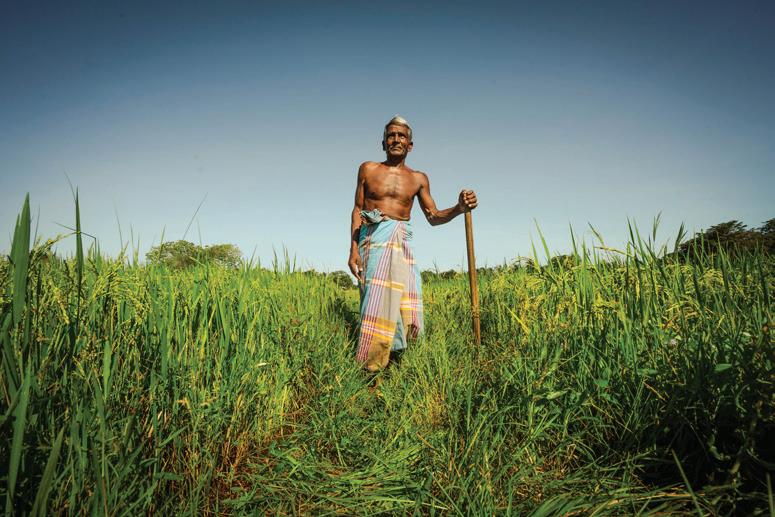
The occasional breeze brings about a cooling sensation; yet otherwise, it’s all sweat and effort for the farmers. As noon sets and the temperature reaches its peak, there’s a halt in work. Sitting beneath a roof of dried coconut leaves and a little makeshift hut made of mud, lunch is served. It is often a combination of rice and three to four vegetables.
Our island’s culture is tied to the tradition of rice farming and although there are new advances in the process of cultivation, at the root of it all the nuances remain the same. Crop health and management for the next couple of months is essential. As it grows and continues to flourish, rice fields attract pests and diseases of various kinds. Traditional practices of protecting the crop include methods based on astrology, chanting of verses and offerings to the gods.
Approximately 115-120 days later, the rice crops are mature and ready to harvest. The fields turn from an emerald green to a dusky dry golden hue. Harvesting can be performed both manually or mechanically. Manual harvesting is highly labour-intensive and requires 40 to 80 man-hours per hectare (one hectare equals 10,000 square metres). Traditionally, harvesting was complemented by the farmers signing ‘goyam kavi’ - folk songs and poetry.
Post-harvest, there’s drying, storing, milling and finally processing of the crop. There are over 2000 traditional rice varieties across Sri Lanka, each with varying nutritional and medical values. At the Resplendent resorts, you will come across several varieties including suwandel, sudu samba, basmati, and kuruluthuda.

VOLUME 01 46

47
CRAFTING HANDS OF THE SOUTH
Deeply connected to Sri Lanka’s ancient history and folklore tales, the art of wooden mask making is a craft that has been passed down generation by generation. Masks are also a distinct element in traditional processions and festivals. Elaborate stories are typically related by dancers wearing masks and are often used during healing rites as well as rituals. The small coastal town of Ambalangoda in the south, close to Cape Weligama, is well known for traditional mask carving and mask performances. These are particularly used in healing rites and rituals and include 18 different types, each focused on a specific illness.
The art of mask making in itself is quite a complex process which requires a great deal of skill and patience. The timber used for the purpose is known as vel kaduru — a tree which is found close to paddy fields or marshy lands. The manner in which a small tree log becomes a mask is quite a fascinating process. A block of wood lays on the table and the host, Tharanga begins to explain mask making and its uses. A hammer of sorts and an assortment of chisels begin its work after drawing a rough outline of a face on the block. It’s a lot of hammering and chipping away at this point. There’s an art and technique to it too; hammer and chip too hard and much, you’ll lose too much wood. It’s all about taking your own time and being patient in order to intricately add depth to the mask.
Once a basic outline has been created, it’s time to sand in order to create smooth and curvy features. The final step is paint. There are other masks to use as a guide, although the fun and thrill is to veer off the original design and inspire change. This is an engaging activity for the entire family to round out the perfect cultural immersion.
If you would like to learn more about the Crafting Hands of the South experience, kindly email us at reservations@resplendentceylon.com

VOLUME 01 48
GIHAN KARUNARATNE

Operation Manager / Cape Weligama
NATASH A ARUMUGAM
Ops Support Manager - Resplendent Ceylon
Gihan is the face of Cape Weligama and will greet you with his charming smile and confidence. He is always proactive when it comes to the needs and requests of our guests, ever supportive of his fellow ambassadors, and has also received notable positive feedback on TripAdvisor for his generous behaviour.
Natasha is the go-getter at our Head Office, undertaking experience curation, guest events and offering operational support at the resorts. Armed with a positive attitude, a need for being on the constant move, she is sociable, hardworking and compassionate. It is in her nature to lend a helping hand and support her fellow ambassadors when the need arises.

lie the dedication Meet some of the friendly faces you will encounter
At the heart and soul of Resplendent,
PEOPLE OF
49
OF RESPLENDENT
dedication and passion of our ambassadors. encounter at our resorts and head office.
NETHMI MADUSHANI
Commis Chef / Ceylon Tea Trails
PRADEEP SURANGA
Senior Ranger, Birding Specialist / Wild Coast Tented Lodge
Nethmi is patient, always willing to learn and a great addition to the Ceylon Tea Trails team. She loves challenges and carries a very positive attitude. She is also a team player who makes work enjoyable for those around her, and is admired by our guests for her personality and flavourful cuisine.


Suranga is great at spotting wildlife during game drives. He is always relaxed and armed with a great sense of humour and wit. He has a natural passion for wildlife conservation, as is a great team ambassador.

VOLUME 01 50

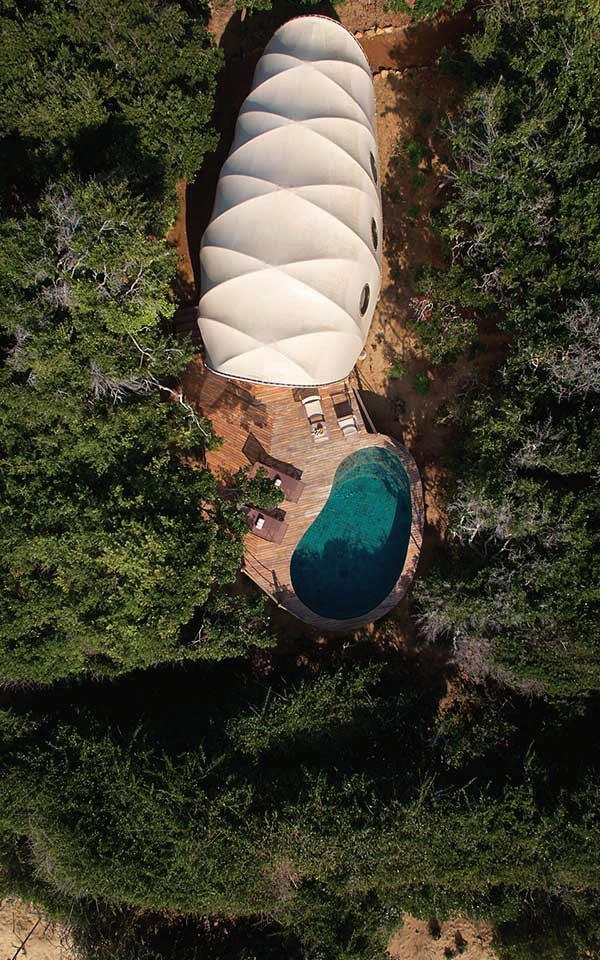
WWW.RESPLENDENTCEYLON.COM Art 28300048-00




















































